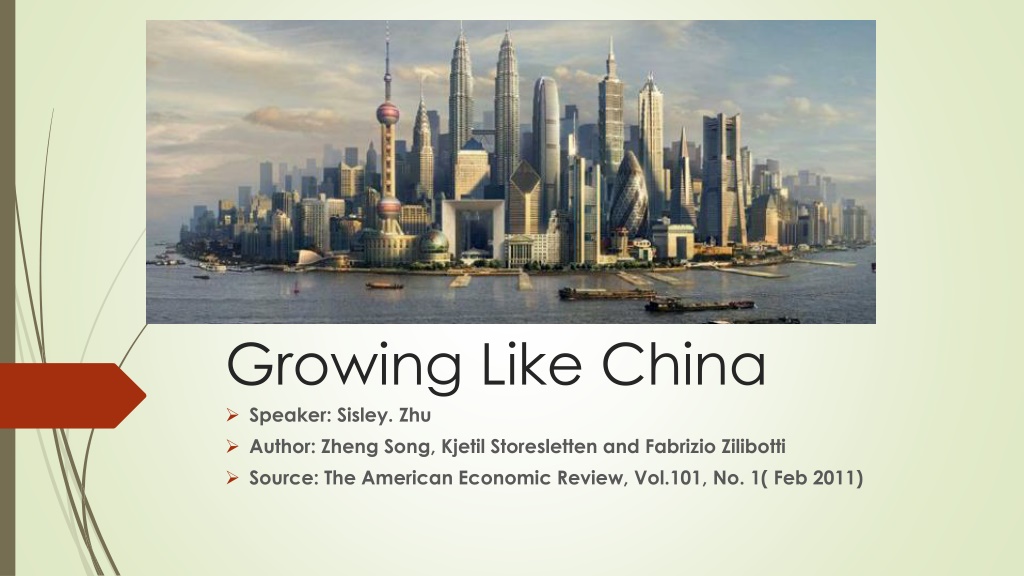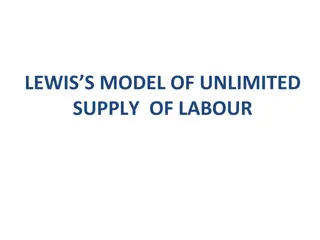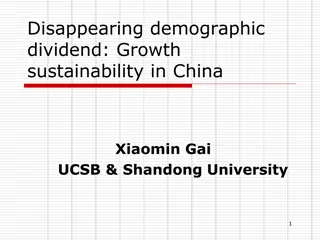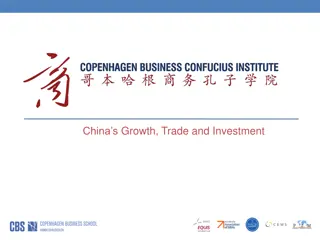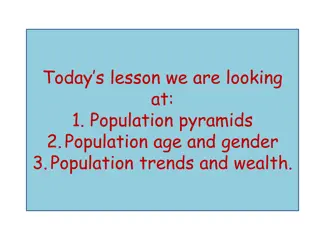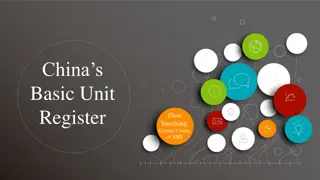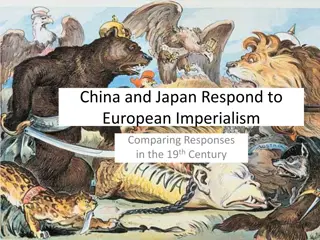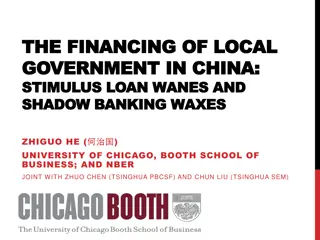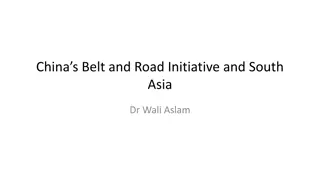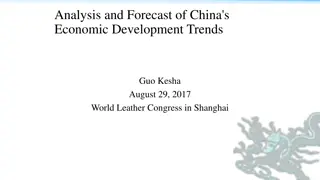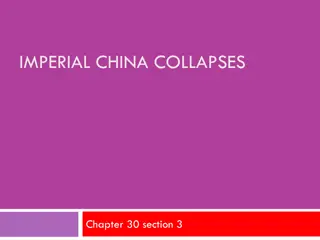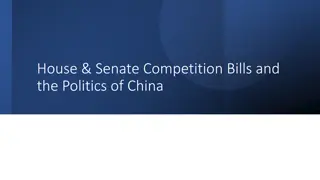Economic Transition in China: A Growth Model Perspective
Analyzing the economic development in China, this study focuses on the puzzle of high output growth, sustained returns, and a large trade surplus. It explores the transition from state-owned enterprises to domestic private enterprises, highlighting the productivity differences and funding mechanisms. The timeline includes key reforms and milestones in China's economic journey.
Download Presentation

Please find below an Image/Link to download the presentation.
The content on the website is provided AS IS for your information and personal use only. It may not be sold, licensed, or shared on other websites without obtaining consent from the author.If you encounter any issues during the download, it is possible that the publisher has removed the file from their server.
You are allowed to download the files provided on this website for personal or commercial use, subject to the condition that they are used lawfully. All files are the property of their respective owners.
The content on the website is provided AS IS for your information and personal use only. It may not be sold, licensed, or shared on other websites without obtaining consent from the author.
E N D
Presentation Transcript
Growing Like China Speaker: Sisley. Zhu Author: Zheng Song, Kjetil Storesletten and Fabrizio Zilibotti Source: The American Economic Review, Vol.101, No. 1( Feb 2011)
Outline The Puzzle Empirical Evidence Benchmark Model Equilibrium Characters Wrap Up My opinion
Closed Neoclassic Economic Model Y = AF ( K , L ) Labor Capital Production function Technology Level GDP
Open Economy Model Saving Investment = NX (Net Exports) Saving > Investment NX > 0 Saving < Investment NX< 0 Lend To Foreigner Borrow From Foreigner Trade Surplus Trade Deficit Net Capital Outflow > 0 Net Capital Inflow > 0
PUZZLE! The Puzzle CHINA Growing Trading Surplus Neoclassical Economic Model High Growth Open Economic Model High Return to Capital
General Idea Construct a growth model to resolve this puzzle in China At the same time, be consistent with China s economic transition: High Output Growth Sustained Returns Large Trade Surplus
Our focus would be here ! Timeline 1978 1997 1992 Reforms Acceleration 15th Congress of the Communist Party of China Endorsed increase of private firms New stage of reform launched Deng Xiaoping s Southern Tour First Economic Reforms
Reallocation in Manufacturing Domestic Private Enterprises State owned Enterprises
DPE vs SOE Domestic Private Enterprises State Owned Enterprises More productivity Less productivity Strong discrimination to credit markets Easily get external funding from credit markets Rely heavily on internal funding E.g.: retained earnings and family or friends to finance investment Rely on external financing E.g.: major bank mortgage
Income Inequality In this economic transition, China experienced a increase in income inequalities. Gini Coefficient of income in China grew from 0.36 in 1992 to 0.47 in 2004 The slow growth of wages relative to entrepreneurial income More private firms ->higher income dispersion
Foreign Surplus and Productivity Growth Use data for 31 provinces with NBS data from 1992 to 2004 to perform regression Foreign Surplus: Y = Net Surplus-to-GDP ratio ; X = employment share of DPE Results: The net surplus is systematically larger in provinces with a larger increase in the DPE employment share which lead to foreign surplus. Growth Rate: Y = Growth rate of GDP ; X = employment share of DPE Results: Labor productivity has grown faster in provinces where the DPE employment share has grown faster.
Model Setup : Populations I am a worker. I don t have entrepreneurial skills . Nt Nt+1 = Nt (1+v) Agent a I am a worker. I have entrepreneurial skills . Nt Nt+1 = Nt (1+v) Agent b
Model Setup : Population Utility Time-separable utility function Assumption: Two-period lived agents will work in the first period and live off savings in the second period. C1t : Consumption @ 1t > = 1: the intertemporal elasticity of substitution in consumption Ct Beta : discount factor
Model Setup : Firms Owned by intermediates Operate as a standard neoclassical firm Financial Integrated Firms Access to credit markets Firm F Retained direct control Owned by old entrepreneurs Hire their own children Entrepreneurial Firms Firm E Restricted external funding Delegate decision authority to the manager
If Firm F choose delegation Advantage: Delegation leads to higher Total Factor Productivity. Firm F Manager make decisions based on superior information Firm could attain ? > 1 extra efficiency units per worker compared with Firm E Disadvantage: Agency problem: the manager can divert a positive share of the firm s output for his own use Solution is to pay managers a compensation that is at least as large as the funds they could steal
But for Firm E Key assumption is that entrepreneurs are better at monitoring their managers So that Firm E managers can steal only a share ? < 1 of output
Model Setup : Technology A: Technology Parameter. At+1 = (1+z)At K : Capital n: Labor Y : output
Model Equilibrium : Agents savings Iceberg Cost : Domestic Firms Young Worker Rl Deposit Saving St Rd Banks Foreign Bond R Wage w Budget Constraint: C1t+ C2t+1/Rd= Wt Consumption Maximize Utility
Model Equilibrium : Agents savings In competitive equilibrium: Rd= R = RL*(1 )
Model Equilibrium : Agents savings Young Entrepreneur Deposit Rd Banks Consumption Compensation mt Lend a limited portion to domestic firms Repay share of net profit Family Business
Model Equilibrium : Agents savings Consider now the value of an E firm, owned by an old entrepreneur with capital KEt . This value is the solution to the following problem: Subject to the following incentive constraint: Thus, the optimal compensation is :
Model Equilibrium : Agents savings Taking the first-order condition with respect to nE and substituiting in the equilibrium wage given by (2) yields that Plugging the above equations to the maximum equation, we get the optimal firm E s value :
Model Equilibrium : Agents savings E firms prefer delegation to centralization Young entrepreneurs find it optimal to invest in the family business A sufficiently larger productivity difference is necessary to trigger economic transition!
Model Equilibrium : Agents savings Firm E s capital kEt is composed of: Incentive-compatibility constraint of the entrepreneur The share of investments financed through bank loans is : C1 = m SE C2 = E ( lE + SE ) Rl lE
Model Equilibrium : Agents savings Maximize the utility function with the above constraints
Equilibrium Characters Capital per effective unit of labor kJ = KJ / (AJ nJ ) Lending Rd = Marginal product of capital of F firms Thus, we substitute the above equation and put into nE:
Equilibrium Characters KET and At are state variables Capital per effective unit of labor for each type of firm, kE and kF, is constant for each type of firm Entrepreneurial savings in period t is linear in KET The employment, capital and output of E firms grow at a constant rate during transition
Equilibrium Characters For firm F: Firm F hire all workers not employed by Firm E and KF adjusts to the optimal capital-labor ratio As long as the employment share of E firms increases, the growth rate of KF declines over time. The aggregate capital accumulation of F firms is hump-shaped during the transition. Initially, when the employment share of E firms is small, KF grows at a positive rate. However, as the transition proceeds, its growth rate declines and eventually turns negative
Equilibrium Characters Average rate of return for the all economy is : Indicates that as long as Net/Nt increases, the ? will increase Hence, explain the reason that the increase of private enterprises accounts for the consistent growth of China s capital return
One more PUZZLE. Foreign Surplus
Equilibrium Characters Let s look at the bank s balance sheet Deposit Loan to E Loan to F Foreign bond
Equilibrium Character As long as the NET/Ntincreases, the country s foreign surplus per efficiency unit, Bt/(At Nt) increases. When the transition is completed in period T and all workers are employed by E firms (NET/Nt = 1), the net foreign surplus becomes: If the E firms remain sufficient credit constraints (i.e the is very low), then the transition necessarily ends with a positive net foreign position
Wrap-Up E firms(DPE in China) have a higher TFP and less access to external financing with a low capital intensity In spite of high investment and growth rate, the rate of return of firms does not fall Growing like China The transition is characterized by factor reallocation from financially integrated firms to entrepreneurial firms, similar to SOE to DPE Such reallocation leads to an external imbalance- sustained foreigner surplus
My opinion It is a well-constructed model , which implements data, economic theory and quantitative methods to successfully explained the economic transition in China after 1992 However, some assumptions are not appropriate and need to be readjusted E.g. : while assuming F firms to be competitive, the author ignored the market power of the firm, that may be important in Chinese SOE. Deserves further researching on granting market power of Firm F to see if the results would change.
